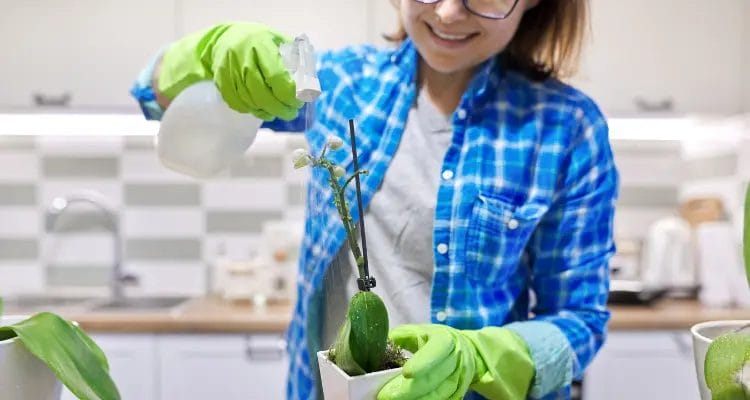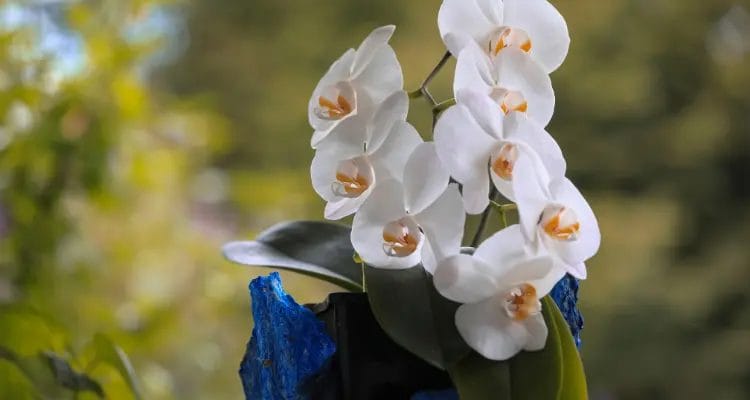The phalaenopsis orchid, also known as the moth orchid, is a common household plant that’s easy to care for. It’s a long-lived and reliable bloomer with usually white flowers but can also be shades of pink or green. It grows in warm climates, including those in the United States. Phalaenopsis is a beauty to own and place in our house or backyard.
Just planting them isn’t enough; you must also take for it. The very first thing that comes to the caring guide is watering. A phalaenopsis orchid planted in bark must be watered every 7 to 14 days. In contrast, a phalaenopsis orchid planted in moss must be watered every 12 to 14 days. Read on to find out more about phalaenopsis.
You may be interested in How to Water Orchids in Moss?
Watering Frequency
I watered my plants every 7-14 days with reverse osmosis filtered water at room temperature. The desert has changed my life now that I’m here. You will also experience this variation.
If you forget about watering them for longer than a few days (or even weeks), don’t fret. Your orchid will still be just fine. This is because they have what’s called an “epiphytic lifestyle.” This means that their roots grow above ground and absorb moisture from the air instead of taking it directly from their medium (in this case, soil), so if your orchid has been without water for some time but remains healthy-looking and green, then congratulations. You’ve got yourself a strong specimen that can handle some neglect every now and then.

How much water phalaenopsis demands?
After your orchid’s potting mixture has dried or largely dried, you can water it again. In a moderate climate, phalaenopsis, or moth orchids, generally need watering every 1-2 weeks. In addition, you should water the plant once a week during the summer months and twice a month during winter.
If you have a large orchid, such as amaryllis, you may need to water more frequently than this. You will also need to water larger plants more often when they are growing rapidly. If you notice any signs of dryness on the leaves of your orchid, such as yellowing or browning, you should water it immediately.

How to Water Phalaenopsis Orchids
Depending on how you choose to water your orchid, there are several options. Everything about orchids is situation-dependent, so what’s the best orchid? The growing medium plays an important role in this case.
When growing orchids in the bark or another well-draining medium, make sure to soak their roots in plenty of water. After the potting mixture has been soaked well, the excess water should be drained from the pot. In addition to ensuring that airflow returns to the roots, it will also prevent mineral salts from building up in the growing medium. Keep the roots submerged in water no longer than 15 minutes, as soaking them for more than that can cause them to become waterlogged.
If you want to soak the potting mixture for 10-15 minutes, you can place the orchid pot in a sink or large container partially filled with water. To prevent the spread of disease among your potted orchids, you should use separate containers for each pot.
The roots can also be soaked by slowly and thoroughly watering them from above with a narrow-spouted watering can. Water will be delivered directly to the roots, not washed away with the potting mixture or wetted crown.
Using these methods to water, your orchid risks drowning the roots if the growing medium is sphagnum moss. Soaking this material continuously keeps the inner core moist since it is so absorbent. Consequently, each time you water your plant, you only have to provide two or three tablespoons of this growing medium.

Here are a few things to keep in mind while watering phalaenopsis:
Drainage
Orchid roots don’t like being constantly wet. They prefer to sit dry in the air. And if you keep them sitting in water, they’ll rot. So how do you know if your orchid is getting enough water? You check the bottom of the pot. Do you see any dark brown spots? Those are signs of too much moisture. If there aren’t any spots, then you’re good.
Suppose you’re growing epiphytic orchids, such as spider orchids. In that case, you don’t need to worry about drainage holes because those plants grow on other plants. But if you’ve got terrestrial orchids, ensure you let the soil dry out completely before adding more water.
A very common way to kill off your orchids is overwatering. When you water your plant, ensure you never let the water stand around for longer than 10 minutes. Watering your orchid every day isn’t necessary. In fact, it could actually cause harm. Because orchids are sensitive to humidity, keeping them in a humid environment is best.
And finally, if you’re planting your orchid in a decorative container, ensure you’re taking the container out of the regular pot to allow proper drainage.
Pot Size and Material
A variety of sizes are available for orchids. If you have a 3-inch pot, Watering this orchid is more frequent than its larger counterparts in pots 6 inches deep. An orchid’s water will increase with a larger pot, but less frequent watering will be required.
There will also be a difference in the pot’s material. Plants planted in porous terracotta take more time to dry out than those planted in plastic.
The Planting Medium
In addition to orchid bark, the orchids can also be planted in moss, sponge rock, or even cork (mixes may include bark, rocks, moss, sponge rock, and cork). Soil is not the place to plant them. You need to water your orchid more often if it’s planted in bark than if it’s planted in moss.
Moss will hold moisture longer than bark, allowing the water to drain easily. Because I am more comfortable with bark or predominately bark mixtures, I tend to water them correctly.
Timing
Orchid enthusiasts are often advised to water orchids during the day since it provides sufficient sunlight to dry the plants overnight. However, some experts also suggest watering orchids in the evening because the soil dries faster at night. This helps prevent fungal and bacterial issues.
The best way to water orchids depends on the type of plant. For example, potted orchids require daily misting, while hanging baskets usually do fine with weekly watering. If you’re unsure about how much to water, check with a local nursery or home improvement store. They’ll know what works best for your specific species.
Types of water
Orchids require a special kind of water, and there are many opinions on what kind is best. Others use reverse osmosis, while some use distilled or purified water. Take the time to search for the best water for you on your own. There is no need to worry about your tap water.
To ensure that your orchids receive the nutrients they need, supplement with fertilizer unless you’re using rainwater. Once a month, I use 1/2 strength of this fertilizer on mine.
Don’t overwater
Don’t overwater them by watering them too frequently or letting them sit in water. – Don’t use salty or mineral-rich water. – Determine how often to water based on their environment.
Frequently Asked Questions
Orchids: What Are They?
What is the maximum temperature for phalaenopsis?
When should I water my Phalaenopsis orchid?
What is the best way to water an orchid?
During the bloom, should I water my orchid?
Conclusion
Phalaenopsis orchids are one of the most common orchids in the world, making great houseplants. They grow best in bright light and with lots of air circulation, but they don’t need a lot of water. The key is to ensure your orchid doesn’t get too dry between waterings—this will cause it to stop producing new leaves and flowers. If you follow these simple instructions, your phalaenopsis will thrive.






